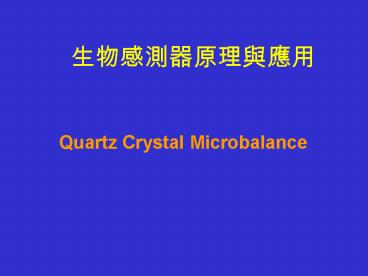Quartz Crystal Microbalance - PowerPoint PPT Presentation
1 / 15
Title:
Quartz Crystal Microbalance
Description:
common choice because it does not oxidize in air. If gold is ... thiols, SiO2, and oxidized gold surfaces respectively. CHARACTERIZATION OF ADSORBED PROTEINS ... – PowerPoint PPT presentation
Number of Views:2655
Avg rating:3.0/5.0
Title: Quartz Crystal Microbalance
1
??????????
Quartz Crystal Microbalance
2
What does QCM stand for?
QCM stands for Quartz Crystal Microbalance.
3
What other abbreviations are used for QCMs?
A Quartz Crystal Microbalance is sometimes called
a QMB, for "Quartz MicroBalance".
When used by electrochemists, a QCM is often
called an EQCM for "Electrochemical Quartz
Crystal Microbalance".
4
What is a QCM, physically?
Physically, a QCM consists of a thin, usually
round, slice of crystalline quartz with an
electrode on each side. The slice is cut in a
particular orientation called an "AT-cut".
The electrode can be made of any metal, but gold
is the most common choice because it does not
oxidize in air. If gold is used, a thin
"undercoat" of chromium is usually put onto the
quartz first. This is because gold by itself
does not stick all that strongly to quartz.
However, chromium sticks well to both gold and
quartz. So using a chromium undercoat improves
adhesion.
5
How does a QCM work?
If the two electrodes are put at different
potentials an electric field results across the
QCM, i.e. in the "Y direction". Because of the
piezoelectric properties of quartz, such an
electric field in the "y direction" couples to
shear motion "around" the z-axis, and vice
versa. The end result is that shear waves in the
quartz, in which the mechanical displacement is
in the "x" direction, also called the electric
axis, are coupled to voltage between the
electrodes.
6
What are QCMs used for?
Almost all QCMs are used as sensitive detectors
of mass deposited on them. This added mass
decreases the resonant frequency of the QCM. By
measuring the decrease in the resonant frequency
of the QCM, and knowing something about the
physics of the QCM you can calculate the added
mass per unit area on the QCM. Because frequency
changes can be measured to very high precision,
QCMs are very sensitive. They can measure
amounts of deposited material with an average
thickness of less than a single atomic layer.
Hence the "microbalance" part of their name.
7
What is a simple useful approximate equation for
the frequency shift of a QCM as a function of
added mass?
1957, Sauerbrey
8
Application areas
- Biomolecular adsorption
- Antibody-antigen interactions
- Cell adhesion
- Polymer science
- Marine biofouling
- Surfactants
- Surface Coatings
9
ADSORPTION OF SAMS
10
ANTIGEN-ANTIBODY REACTION
First HSA (a 67 kD protein, present in blood) is
introduced to the surface (a). Upon adsorption, f
decreases in proportion to the increased mass on
the crystal while D increases only
slightly, indicating a fairly rigid film.
The frequency change corresponds to a mass change
of 180 ng/cm2. In the next step (b) the sensor
surface is rinsed from excess HSA by buffer. An
antibody against HSA (150 kD) is added (c). The
decrease in f shows that the antibody binds to
the HSA on the sensor surface. A significant
increase in D indicates the formation of a
non-rigid layer of antibodies. Finally the
surface is rinsed again with buffer, which
removes loosely bound antibodies (d).
11
BIOFILM FORMATION
12
(No Transcript)
13
LIPID VESICLE ADSORPTION
Monodisperse phospholipid vesicles (25 nm
diameter) were deposited on sensor crystals with
alkane terminated thiols, SiO2, and oxidized
gold surfaces respectively.
14
(No Transcript)
15
CHARACTERIZATION OF ADSORBED PROTEINS

